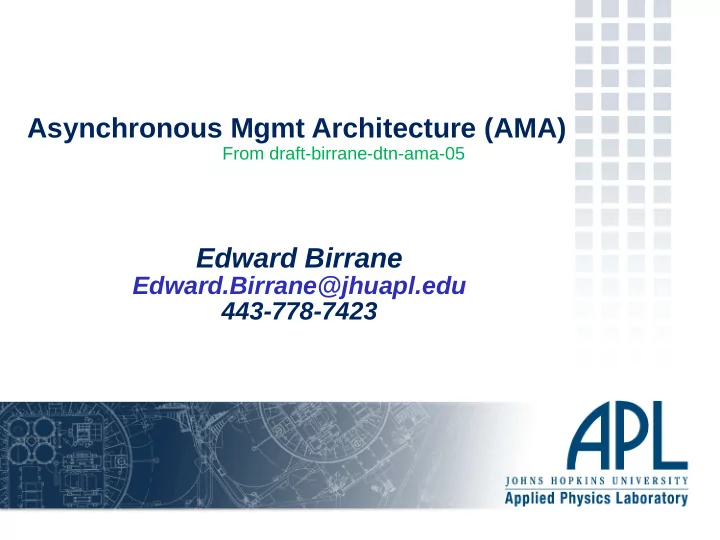

Asynchronous Mgmt Architecture (AMA) From draft-birrane-dtn-ama-05 Edward Birrane Edward.Birrane@jhuapl.edu 443-778-7423
AMA: Updates AMA: Updates From -04 to -05 Minor Terminology and Definitions Updates Mostly wordsmithing based on feedback. No significant issues or limitations with the architecture. No “structural” changes to the architecture.
AMA: Introduction & Motivation AMA: Introduction & Motivation Document purpose Motivation, Service Definitions, Desirable Properties, Roles/Responsibilities, System Model, Logical Data Model Not a prescriptive standard, informative guidance. Scope Challenged networks where asynchronous operation is required. Assumes naming, addressing, integrity, confidentiality, authentication, fragmentation, security, etc… already provided. Does not address interface with synchronous network management. Motivation Asynchronous management requires: • Autonomy model, less reliance on sessions and per-operation state sync. SNMP/NETCONF don’t provide these capabilities. • Work in RESTCONF might Provide a standard model to converge efforts in this area.
AMA: Service Definitions AMA: Service Definitions Configuration Create new datum as function of other data (C = A + B) Ex: Create new reports (RPT = {A, B, C}) Ex: Store pre-defined actions (IF (X > 3) THEN Cmd(Params) Reporting Push data, don’t pull. Ex: Push as a function of time (Generate report every hour) Ex: Push as function of state (Generate report if (X > 3)) Autonomous Parameterized Procedure Calls Manage” agent asynchronously by coding response options. Allow for behavior to be customized through parameterization. Ex: Update local route info based on local link analysis Ex: Manage storage to enforce quotas Ex: Apply or modify local security policy Administration Finer grained access control for operations.
AMA: Desirable Properties AMA: Desirable Properties Intelligent Push Asynchronous operation doesn’t support round-trip pull requests. Absolute Data Identification Data must be atomically identifiable • Should not need multiple rounds of synchronization to figure out where data lives in an array, for example. • E.g., support associative looks-ups Custom Data Definition Define new data (variables) local to an agent. Autonomous Operation Automation of pre-defined tasks, Autonomy to self-configure same. Distributed operation allows for decentralized control/execution. Deterministic Behavior – Ability to forensically reconstruct events. Engine-Based Behavior – Ability to avoid mobile code where needed.
AMA: System Model AMA: System Model Agents Run on Managed Devices Configure/Report on devices Heavy autonomy and parameterized control Manager(s) Collect/Fuse data from Agents Configure Agent behavior Open-loop control ADMs Well-named Data and Controls Superset of MIB Move to describe them in YANG Preconfiguration reduces msg size
AMA: Roles/Responsibilities AMA: Roles/Responsibilities Agent Responsibilities Application Support – Manage local applications/protocols. Local Data Collection – Collect and/or calculate new values. Autonomy Control – Apply time/state based response options. User Data Definition – Store/remember user-defined data variables. Autonomous Reporting – Push reports based on time/state. Consolidate Messages – Where possible, reduce overhead. Regional Proxy – Collect from other nodes in a region. Manager Responsibilities Agent Capabilities Mapping – Common picture of agent abilities. Data Collection – Receive data from multiple agents. Custom Definitions – Send user-defined data to agents. Data Translation – Interface with other network management systems. Data Fusion – Generate new data from received data.
AMA: Logical Data Model (ADM) AMA: Logical Data Model (ADM) “Atomic” Elements An ADM defines 8 types of data for Solely defined by their ADM. each application/protocol managed EDDs : collected by agents. in the AMA. Literals: useful constants. Ops: opcodes for math functions. Ctrls: opcodes for agent behavior. “Variable” Elements Defined by ADM or by User ADM definitions are immutable. Vars : strong-typed variables, including a type for “expression”. Macro : Ordered set of Ctrls. Rpts : Ordered sets of data Rules: Time or State based autonomy.
AMA Control and Data Flows AMA Control and Data Flows
AMA Serialized Management Control AMA Serialized Management Control Flow Flow
Multiplexed Management Control Multiplexed Management Control Flow Flow
Data Fusion Control Flow Data Fusion Control Flow
Thank you! Thank you! Questions? 13
Recommend
More recommend